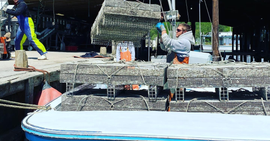Oysters are delicate and need precise care during delivery to remain safe and flavorful. Here's how distributors ensure top quality:
- Temperature Control (29°F–32°F): Prevents spoilage and extends shelf life.
- Specialized Packaging: Insulated boxes with gel packs or dry ice.
- Fast Shipping: Minimizes transit time.
- Real-Time Monitoring: Tools like Timestrip indicators track temperature.
Even slight temperature changes can spoil oysters. Distributors use refrigerated vehicles, moisture-control materials, and route optimization to deliver oysters that are safe and ready to enjoy.
Temperature Control Methods
Required Temperature Ranges
Maintaining precise temperatures is key to keeping oysters safe and fresh. During transit, oysters should be stored between 29°F and 32°F - a narrow range that preserves quality without risking freezing damage [1].
The National Shellfish Sanitation Program mandates that oysters must be cooled to 50°F or lower within 10 hours of harvesting [2]. After this initial cooling, consistent temperatures are essential to extend shelf life.
"Obviously, [oysters are] a fresh product and a cold temperature is critical because they're consumed raw and you need to keep them safe... We can make sure that that product is staying below 45 degrees for its entire journey. Once we get into two or three days, it's a little more questionable." - Chris Sherman, CEO of Island Creek Oysters [3]
This careful temperature management sets the stage for the advanced cold chain equipment used in oyster distribution.
Cold Chain Equipment
Distributors rely on advanced cold chain systems to keep oysters at the right temperature throughout delivery. Here are the key tools they use:
Refrigerated Vehicles
Refrigerated trucks and vans come equipped with:
- Temperature-controlled systems
- High-quality insulation
- Built-in air circulation for even cooling
- Optimized loading to reduce temperature fluctuations [1]
Monitoring Systems
Companies like Island Creek Oysters, which ships over 100,000 oysters weekly, use cutting-edge temperature tracking tools like Timestrip PLUS indicators [2]. These devices monitor for temperature breaches above 50°F, enabling quick action if issues arise.
"We are shipping thousands of individual consignments every year and with a Timestrip PLUS TTI in every box we know that our oysters had a safe trip!" - Emily Weedon, Island Creek [2]
Specialized Packaging
Packaging plays a critical role in maintaining temperature stability. Common solutions include:
- Insulated cardboard boxes paired with frozen gel packs
- Strategically placed ice packs or dry ice [3]
Distributors often combine these tools with express delivery services. For instance, Island Creek Oysters partners with FedEx, using specially designed packaging to ensure the oysters stay below 50°F throughout transit [2].
Packaging Methods
Moisture Control Materials
Keeping oysters fresh requires careful moisture management. Today's packaging solutions use materials designed to maintain proper hydration levels without oversaturating the product.
Some eco-friendly replacements for polystyrene foam include:
- Recycled denim insulation
- Natural wool padding
- CoolSeal boxes with moisture-resistant surfaces and draining bases [4]
To avoid moisture-related problems, distributors often add insulated liners inside corrugated cardboard boxes. These liners help regulate humidity and manage condensation during transit [5].
Reusable gel packs are another key component, offering both cooling and moisture control. These packs are placed strategically to avoid direct contact with the oysters while still providing the necessary temperature and humidity balance.
Proper ventilation is just as important to ensure oysters stay in top condition.
Air Flow Management
Good airflow plays a major role during transportation. When combined with accurate temperature regulation, it helps preserve oyster quality.
Modern packaging includes features that promote ventilation, such as:
- Breathable containers with mesh inserts
- Well-placed vents for airflow
- Seals that allow oxygen exchange [6]
In refrigerated transport, systems are designed to balance CO₂ and ethylene gas levels, maintain consistent temperatures, and allow fresh air circulation without losing cooling efficiency [7]. Reefer containers use evaporator fans to distribute cool, fresh air and remove stale air [7].
Temperature control is especially crucial. For example, every 5.3°C (about 9.5°F) rise in temperature doubles the rate of microbial spoilage in seafood [8]. By combining moisture management with effective airflow, modern packaging ensures oysters stay fresh from harvest to delivery.
Delivery Speed and Timing
Route Planning
How oysters are delivered plays a huge role in keeping them fresh. Delivery services now rely on software to map out the fastest routes, cutting down transit times. This isn’t just about speed - it’s about safety. For example, 27% of consumers have reported issues with unsafe food temperatures during deliveries [9].
Willapa Oysters showcases an efficient delivery system with these options:
| Delivery Method | Arrival Time | Coverage Area |
|---|---|---|
| Next Day Air | By 12:00 PM | Most US locations |
| 2nd Day Air | By 8:00 PM | Most US locations |
| Flat Rate Ground | 2-day maximum | WA, OR, ID, NV |
Taylor Shellfish Farms takes a tailored approach by harvesting oysters fresh to order and letting customers pick their preferred delivery date at checkout [10]. This ensures freshness while keeping logistics under control. Combining route optimization with smart supply chain management keeps oysters in top condition during transit.
Supply Chain Management
Route planning is just one piece of the puzzle. Digital tools now make it easier to manage the entire supply chain. For example, a pilot study by the Gulf States Marine Fisheries Commission highlighted how electronic tracking systems improve delivery from harvest to table [13].
Here are some standout supply chain tools:
- GPS tracking devices with geofencing for location monitoring [11]
- Integrated digital management systems for streamlined tracking [13]
BlueTrace offers shellfish traceability solutions that connect farmers and distributors seamlessly [12]. Taylor Shellfish Farms uses frozen gel ice packs for perishable orders and dry ice for frozen oysters to maintain quality [10].
Modern route optimization tools also provide real-time tracking and adjust routes to avoid traffic delays. These advancements ensure oysters stay fresh and meet the rising expectations for dependable seafood delivery.
sbb-itb-5051793
Quality Control Steps
Initial Quality Checks
At the source, workers check each oyster for freshness by tapping its shell - oysters that don't close are discarded [14]. Shells are rinsed gently under cold water, and shipments are labeled to ensure traceability [14][15].
Temperature Tracking
Temperature is monitored using tools like TTIs (Time-Temperature Indicators) and data loggers to ensure oysters stay below 50°F within 10 hours of harvest [2]. Here's how some tools are used:
| Monitoring Tool | Key Features | Best Use Case |
|---|---|---|
| Timestrip PLUS TTIs | Visual alerts for temperature breaches, 2–4 hour tracking | High-volume shipments |
| Smart Button Logger | Reusable, continuous monitoring | Premium deliveries |
| TT Sensor Plus 2 | Smartphone data download, single-use | Direct-to-consumer |
Island Creek Oysters, managing over 100,000 oysters weekly, uses Timestrip PLUS indicators alongside frozen gel packs in each shipping container to maintain proper temperature [2].
"We are shipping thousands of individual consignments every year and with a Timestrip PLUS TTI in every box we know that our oysters had a safe trip!" - Emily Weedon, Island Creek [2]
Arrival Inspections
When shipments arrive, inspectors check that oysters are at 45°F or lower using calibrated thermometers. They are then cooled to 41°F within four hours [16]. Inspections also confirm proper labeling, intact packaging, and clean delivery vehicles. Any shipment showing signs of contamination or temperature issues is rejected [16]. These steps ensure only the freshest oysters make it to their final destination.
Wholesale Packing Process - Oyster Delivery Preparation
Little Wicomico Oyster Co. Delivery Process
Little Wicomico Oyster Co. combines careful packaging with precise temperature control to ensure their oysters arrive in top condition.
Farming and Harvesting Methods
Located on Virginia's Little Wicomico River, this fourth-generation family business takes pride in hand-harvesting oysters. Their oysters take 18–36 months to grow to the ideal size, with water quality constantly monitored to determine the best harvesting times. Workers harvest the oysters by hand and pack them immediately at the dock, minimizing temperature changes and preserving freshness [18].
Blackberry® Reserve and Product Line
The Blackberry® Reserve Oysters, available from October to March, require careful handling to maintain their signature taste. The company's shipping schedule ensures customers receive the freshest product possible:
| Shipping Schedule | Order Timing | Delivery Details |
|---|---|---|
| Same-day shipping | Before 10:00 am ET | Ships immediately |
| Next-day shipping | After 10:00 am ET | Ships on the following business day |
| Future date orders | Any time | 2-day shipping; order sent 2 days before the delivery date |
To keep oysters fresh, customers are advised:
"Store live/shelled oysters in the fridge or in a cooler on ice, ensuring they don't sit directly in ice water. If storing for more than 3 days, cover them with a wet kitchen towel to prevent drying out." [17]
A customer shared their experience, noting that even with a 24-hour weather delay, the oysters still arrived fresh [19].
The company’s dedication to delivering freshness is clear in their statement: "From harvest to delivery, our oysters take the most direct route possible to remain fresh, straight to your door" [18]. To enjoy the best flavor and quality, they recommend consuming the oysters within 48 hours of harvest [18].
Conclusion
Delivering oysters in peak condition requires careful temperature management, smart packaging, and well-organized logistics. Even a slight rise in temperature can drastically cut their shelf life [1]. Suppliers rely on advanced monitoring tools and strict processes to ensure quality during transit.
Little Wicomico Oyster Co. stands out with its temperature-controlled packaging and same-day shipping approach. As SEAFOOD HEALTH FACTS puts it, the essential rules are simple yet crucial: "Keep it cold, Keep it clean, Store it quickly, Prepare and cook it properly" [20].
To get the most out of your oyster deliveries, follow these tips [14]:
- Store oysters in the refrigerator at a temperature below 40°F (4.4°C).
- Consume them within 7 days for the best taste and freshness.
- Place oysters cup-side down on ice in containers that allow proper drainage.
- Avoid airtight containers, as oysters need air circulation.





